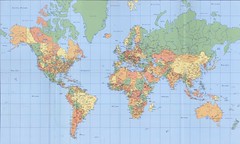Why look at contemporary art — this week
How — next week
Who — third week
Art is a cultural product for human interaction
- Calling it art doesn’t mean it is good. There is bad art.
- Focus on how to engage with the art our culture is producing. Slides will include art we like, and art we don’t.
“Art is art because it encapsulates a part of the human experience and elicits a response.” David Giardiniere, It Was Good: Making Art to the Glory of God
- Good art does not leave you where it found you.
“Good art takes us to a world we wouldn't have imagined ourselves. It does not leave us where it found us.” Ken Meyers, All God's Children and Blue Suede Shoes
- Van Ruisdale:

- Common Reactions:
- It is visually pleasing.
- It is skillful.
- Therefore it is good art.
- Therefore it glorifies God.
- Therefore it is true.
- These are common, historically Christian ways of responding to art.
- Hirst slide.
- Empty assertion of title.
- Belongs in a natural science museum.
- Doesn’t fit in any categories of art.
- What kind of shark is it?
- Tempting to throw the shark out the window along with all contemporary art. Contemporary reformed theologians often only want to talk about representational art made before 1920.
“If art is by its very nature part of God’s creation, inextricably historical, conditioned by the society in which it is made, and necessarily permeated by a committed spirit in one direction or another, then I believe it is wrong to view art as a luxury.” - Calvin Seerveld, Bearing Fresh Olive Leaves
- Art is nether superfluous or extraneous. Art is made because there is meaning to what we do.
“Humans have art because they understand, perhaps at an intuitive level, that there is meaning in what we do.” - Tim Keller, It was Good: Making Art to the Glory of God
- Practical: we live in an image-driven culture.
“We live in a generation raised on a steady diet of the visual.” - William Dyrness, Visual Faith
- Movies, ads, websites, all visual.
"The human experience is more visual and visualized than ever before.” - Nicholas Mirzoeff, The Visual Culture Reader
- Tide vs iPod.
- Just as Paul on Mars Hill, contemporary apologetics of God’s truth must engage visual culture.
- Theological: John 1:14.
- The incarnation is visual, the sacraments are visual, the cross was visual.
- The Word becomes flesh, submitting to a certain time and culture. He dressed according to the culture, he spoke in parables that were set in that culture.
- Incarnation compels us to engage art from the culture that produced it.
- Theological: the Christian metanarrative.
- Creation—Fall—Redemption—Consummation.
- Not a linear progression (today is a result of yesterday, which was a result of the day before, so on). But the Christian progression proceeds from our eschatological belief. Our understanding of the past is driven by what we believe about the future.
- Creation’s existence through time is meaningful and worthy of study because Christ is coming back.
- Christians, because we know the ending, are the freest to engage with contemporary art.
- Example: Kiki Smith

- What is the role that art has in contemporary culture?
- Further, does the role of art change over time?

Medievally, art is functional or decorative. Medievals didn’t do still lives or portraits, since it was instructional, didactic.- Smith slide. She looks fat, stretched, distorted, grotesque, cartoonish. You wouldn’t want to hang it behind your couch, but that is why we have museums, so that you can see art but not have to see it every day.
- The technique used to produce the image is reminiscent of the Mercator projection of the earth. The Mercator projection makes Greenland and northern Russia HUGE.

- Contemporary culture is obsessed with making the female body smaller and smaller.
 The technique in My Blue Lake makes Smith bigger and bigger.
The technique in My Blue Lake makes Smith bigger and bigger. - The absurd, broken human being. The grotesqueness of rejecting our multi-dimensional real selves in favor of some distorted, culturally idealized female form and human condition.

- Jesus came to save the grotesque and the sick.
- Taking the metanarrative, we can look at ugly contemporary art and redeem it in our looking, though it may be disconcerting or unsettling. We are tied to our cynical, grotesque culture, but Jesus offers redemption to that culture too.
- But I couldn’t have understood the Smith slide without that background explanation.
- Just look at the piece and make associations. What does it remind me of visually? A map? What kind of map, what makes that map special, etc.
- Nothing in the explanation given used anything extra outside of just looking. No artist statement, no critical theory, etc.
- What did the artist intend, what is the statement? There seems to be no intent, not like older pieces of art.
- But if we train ourselves to work with contemporary visual associations like we did with the map.
- Hearing the Smith example made me realize that I’ve been arrogant when I walk through a gallery, not wanting to really understand what the artist is bringing forth with their work.
- I could have never come up with the ideas you put forth in your reading of the Smith work.
- Contemporary art museums like the Kemper have education directors that are just there to walk through a gallery with you and give you some meaningful prompts and associations.
- Museum’s web sites often have lots of important biographical information so that you can research before or after your visit.
- Is the textual hermeneutics idea of communities of discourse and hermeneutical spiral useful for art?
- Yes, interpretation is best done in community.

No comments:
Post a Comment